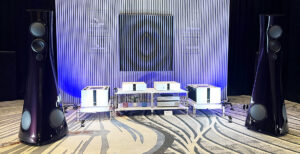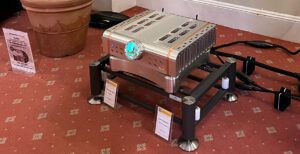
CES is the annual hub for consumer electronics. The world’s technology makers, sellers, and press are all assembled together for a week in early January, to paw over the latest (and occasionally greatest) consumer electronics products. But it can be trumped – I was sitting in a conference several years ago when the Apple iPhone was announced at a rival expo, and news services began packing up their equipment mid-way through the keynote speech. This year, the tragic events unfolding on the streets of Paris overshadowed much of what took place in Las Vegas, effectively silencing the mass media on the subject. CES is a bit of a bubble in and of itself, but many journalists were seen wearing ‘Je Suis Charlie’ stickers on their press passes in sympathy.
Although this year saw highest-ever attendance figures and the booths in ‘the zoo’ (the Las Vegas Convention Center) were mobbed, the specialty audio section was a distinctly quieter event than usual. In part, this was down to a lot of the European manufacturers and distributors deciding that there was no point coming to Vegas if high-end audio comes to Munich in May, and Asian manufacturers and distributors increasingly looking to CES Asia and the Hong Kong Audio Show as viable alternatives to Sin City. However, the show also marked something of a return to form for the home market, with US distributors and dealers forming a significant proportion of the show’s traffic. Frankly, the lack of T.H.E. Show (which is focusing on Newport Beach later in the year) had more effect than might be expected, and the number of weird and wonderful designs in general, and ornate turntable fantasies in particular, was sorely missed.
The show was not without its interest, however. And one point of interest for many was changes over at Audio Research. Terry Dorn, former head of ARC, has stepped down; his replacement, Mike Tsecouras, comes from a Texas Instruments background. Fortunately, Mike is no simple bean-counter; he was the person who started TI’s digital audio division, who started the Burr-Brown division, and has been a keen member of the Audio Research ‘family’ for many years, having been at first a keen user of the company’s products and more recently an active participant in the design of many of its products. His taking on the roles of CEO and CTO at the company is a logical step for so passionate an audiophile, and we joked that the reason he’s taken on Audio Research is to find some space to store those ARC boxes that clogged up his garage! On a personal note, if there’s someone in this industry more keen, more dynamic, and more happy to take on the top job in an audio company, please point them out to me!

If last year could be summed up as the rise of streaming, this year it came down to a world of consolidation. Companies that last year added a streaming design to their portfolios were either integrating the technology deeper into the range, or had quietly dropped the idea. Perhaps the most ambitious system integration concept of all was that by Boulder, in its upcoming 2120 digital converter. A fully UPnP and DLNA compliant media renderer, the DAC (itself the size of most power amplifiers) is actually five separate chassis in one, with the control architecture connected to the rest of the DAC by 10GHz comms and Ethernet connection. Not only does this help keep the noisier sections of a streamer away from the ultra-sensitive 32-bit, 384kHz/Double DSD DAC stage and the dual mono outputs, but it also presages a new way of designing ‘front ends’ for Boulder equipment in general; subsequent preamps and even power amps will sport a more Ethernet-enabled front panel, not only to lower noise, but to allow a wider window on the functions of the amplifier (it’s a big screen), and allow it to act as a control point that can be driven by any Open Home device. Granted, as the 2120 is expected to cost a little under $60,000 this is grand-scale integration, but the technology is changing fast.

At a more down-to-earth level, Lenbrook is very actively pursuing integration between its NAD, Bluesound, and even its PSB platforms. So, it’s possible to stream music from a Bluesound server to a NAD Masters Series DAC, or even to an Ethernet-enabled active loudspeaker from PSB. The number of permutations and combinations of all three brands is staggering, as NAD is incorporating this kind of connectivity across the board, and even into its new blade rack amplifier system (albeit for control and monitoring), but this seems to be an ongoing trend.

And, speaking of trends, the Big Audio Thing this year was CD-grade streaming service TIDAL. The service was everywhere, to such an extent bandwidth was severely compromised throughout the halls of the Venetian Tower, preventing wi-fi access for visitors!

For all the approaches in this, though, I like the D’Agostino route for its relatively low-cost implementation… which is possibly the first time the words, “D’Agostino” and “low-cost” have been seen together. Dan D’Agostino has developed a variant on the Momentum integrated amplifier called the MLife, which replaces the Momentum’s tone controls with a fully-featured wired and wireless streaming client device, controlled by either the five-inch LCD display or the excellent new iOS or Android app. Momentum owners can choose to upgrade to the MLife variant for about $3,000, while the MLife itself costs $48,000; $3,000 more than the Momentum.

Although big-ticket items were on show throughout CES and its attendant off-piste events, perhaps the other big news was a perceptible shift away from the super-high-end. Faced with an audience of more pragmatic US distributors and dealers, products with ‘sticker shock’ prices were often met with a resounding “I can’t sell that!”. While hardly a return to sensible prices, perhaps audio has finally reached its price ceiling, and manufacturers were mostly using CES 2015 to launch products in the middle of the range rather than the extreme top. So YG showed its excellent new Carmel 2, VTL launched its TL6.5 Series II Signature Line and its entry-level TL2.5i preamplifiers, Ayre showcased a prototype Codex headphone amp and DAC that forms the start of a new lower priced range, and PS Audio announced the new BHK-250 hybrid stereo power amplifier, which takes its name from its designer, Bascom H King.



Of course, the higher-end and even the ultra high-end were well covered, too. Magico’s new QSub18, for example, was a $36,000, 2×18” subwoofer, driven by 6kW of amplification and extensive in-house DSP. So heavy it was bending a marble floor, and so powerful (it needs two 20A sockets to drive it), it was literally dimming the lights on every bass note, but if a job’s worth doing…

We’ll be covering all of these in greater depth over the next week or so, but finally no discussion of the 2015 high-price/low-price dichotomy could be considered complete place without mentioning Wilson Audio. Why? Because it had feet in both camps, launching the new Sabrina floorstanding loudspeaker – the company’s new entry point – and announcing the rebirth of the WAMM loudspeaker at the new top-end of audio. Photos, recorders, and the rest were banned from the WAMM launch, but think of the 2015 WAMM as a taller (and from the front, more slender) version of the Wilson Alexandria XLF, with five adjustable modules for mid and treble (in place of three), above two bass units. This time though, there are no more electrostatic panels. Price was one of the many topics not open for discussion about the WAMM, but expect it to be beyond that of the current combination Alexandria XLF/Thor’s Hammer flagship both in price and performance.

Tags: FEATURED
By Alan Sircom
More articles from this authorRead Next From Blog
See all
AXPONA 2024 Show Report Part One
- Apr 19, 2024

Audio Show Deluxe 2024: A photo show report
- Mar 28, 2024

Paul Messenger 1949-2024: A personal tribute
- Mar 26, 2024

Bristol Hi-Fi Show 2024: See You There!
- Feb 21, 2024











